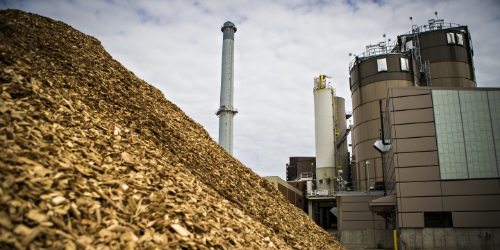This post is one in a series featuring the complete slate of advanced energy technologies outlined in the report This Is Advanced Energy. 
Power generation from biomass (organic matter) covers a range of options. The most common technology is direct combustion, in which solid biomass is burned in a boiler to generate high-pressure steam that turns a steam turbine generator. Biomass resources used for this technology include logging and agricultural residues, forest product residues (e.g., bark, sawdust), agricultural field crop residues, and dedicated energy crops. Biomass co-firing is a similar technology in which biomass is burned along with fossil fuels, typically coal, in the same unit. Plants built with this capability can usually burn any mixture of biomass and coal, while retrofitted coal plants can co-fire up to about 2% biomass without major modifications, or up to about 15% if equipped with a separate biomass handling and feed system. Wood chips are the most common fuel for co-firing, but torrefied biomass is gaining attention. As an alternative to co-firing, old coal-fired power plants can be fully converted (repowered) to burn biomass. Gasification is an alternative to direct combustion whereby solid biomass is converted into a synthesis gas that can be co-fired with coal or used in a gas turbine.
Electricity generated from wood and wood-derived fuels constituted approximately 6% of electricity from non-hydro renewable sources in the United States in 2014, or about 0.4% of total net electricity generation. Biomass is used to generate electricity in 47 states, such as at the 75 MW Burgess BioPower facility in New Hampshire, which produces electricity from woody biomass and sells the power under a 20-year power purchase agreement to Public Service of New Hampshire. Biomass is often deployed as combined heat and power, and many plants make use of agricultural byproducts, such as Koda Energy, a 23 MW CHP facility in Minnesota fueled, in part, by waste oat hulls from General Mills cereal production. Biomass power facilities can also be co-located with biofuel production facilities, as at Abengoa’s cellulosic ethanol plant in Hugoton, Kansas, which began commercial operation in 2014. The plant generates 21 MW of electricity using biomass residues from ethanol production to power the facility and supply electricity to the local community.
Biomass power provides reliable baseload electricity essential for grid reliability. At the same time, the production and transport of biomass feedstocks drive economic activity, particularly in rural areas where it can be an important source of employment. The Abengoa plant in Kansas is expected to generate $17 million annually in revenue for local farmers from feedstock purchases. In 2014, the market for new biomass power installations generated nearly $900 million in revenue — a figure that does not include economic activity associated with existing facilities and their feedstock supply chains. The consumption of biomass feedstock can also improve waste management and land management by making use of otherwise discarded byproducts from logging and agriculture, and by removing fuel buildup on the forest floor, thereby reducing wildfire risk.
